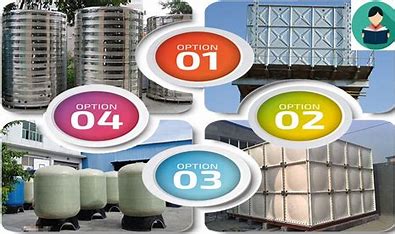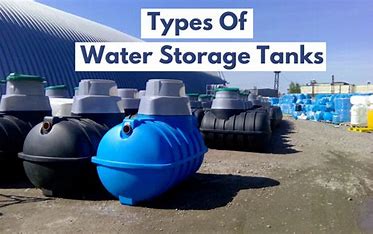Everything You Need to Know About Water Tanks


Water tanks are an essential component of water storage systems, providing a reliable supply for residential, commercial, and agricultural uses. In this comprehensive blog post, we’ll explore the different types of water tanks, their benefits, applications, installation considerations, maintenance tips, and environmental impact.
What is a Water Tank?
A water tank is a container designed to store water for various purposes, including drinking water, irrigation, fire suppression, agricultural uses, and industrial processes. Water tanks can range in size from small, portable containers to large, permanent structures.
Types of Water Tanks
There are several types of water tanks, each suited to different applications and environments. Here are the most common types:
1. Plastic (Polyethylene) Water Tanks
Plastic water tanks are popular due to their lightweight, durability, and resistance to corrosion. They are available in various shapes and sizes and are often used for residential water storage, rainwater harvesting, and agricultural purposes.
2. Steel Water Tanks
Steel water tanks, including galvanized and stainless steel varieties, are known for their strength and longevity. They are ideal for large-scale water storage and are commonly used in industrial and fire protection applications.
3. Concrete Water Tanks
Concrete water tanks are robust and can be either above-ground or underground. They are often used for municipal water storage, irrigation systems, and as cisterns for rainwater collection.
4. Fiberglass Water Tanks
Fiberglass water tanks are corrosion-resistant and suitable for storing potable water and chemicals. They are commonly used in commercial and industrial settings.
5. Bladder (Flexible) Water Tanks
Bladder tanks are collapsible and made from durable, flexible materials. They are ideal for temporary water storage, emergency response, and areas with limited space.
Benefits of Water Tanks
Water tanks offer numerous benefits, making them a valuable addition to various settings. Some of the key benefits include:
1. Water Security
Water tanks ensure a continuous supply of water during shortages, droughts, or supply interruptions. This is crucial for both residential and agricultural needs.
2. Cost Savings
By storing rainwater or other sources, users can reduce their dependence on municipal water supplies, leading to significant cost savings on water bills.
3. Environmental Sustainability
Water tanks promote water conservation by collecting and storing rainwater, reducing the demand on freshwater resources, and mitigating runoff and erosion.
4. Fire Protection
In rural and remote areas, water tanks provide a critical resource for fire suppression, helping protect properties and natural landscapes from fire damage.
5. Versatility
Water tanks can be used for various purposes, including irrigation, drinking water, industrial processes, and emergency water storage.
Applications of Water Tanks
Water tanks are used in a wide range of applications, each requiring specific features and capacities:
Residential
- Rainwater Harvesting: Collecting rainwater from rooftops to use for gardening, flushing toilets, and laundry.
- Emergency Water Storage: Ensuring a backup water supply in case of natural disasters or supply disruptions.
Agricultural
- Irrigation: Providing a steady water supply for crops and livestock.
- Aquaculture: Storing water for fish farming and other aquatic farming activities.
Industrial
- Process Water: Storing water for manufacturing processes, cooling systems, and cleaning operations.
- Chemical Storage: Holding chemicals and other non-potable liquids.
Municipal
- Drinking Water Supply: Ensuring a consistent supply of potable water for urban and rural communities.
- Fire Suppression: Providing water for firefighting efforts in towns and cities.
Installation Considerations
Proper installation of a water tank is crucial to ensure its efficiency and longevity. Here are some key factors to consider:
Location
Choose a location that is easily accessible for maintenance and delivery of water. Ensure the ground is level and stable to support the tank’s weight.
Foundation
A solid foundation is essential, especially for larger tanks. Concrete slabs or compacted gravel bases are common foundation options.
Plumbing and Connections
Install appropriate plumbing and connections to integrate the tank with your water supply system. Include overflow outlets, inlet filters, and outlet valves.
Protection
Protect your tank from environmental factors such as extreme temperatures, UV exposure, and physical damage. Consider using tank covers or enclosures.
Compliance
Ensure your installation complies with local regulations and building codes. Obtain necessary permits and inspections if required.
Maintenance Tips
Regular maintenance is essential to keep your water tank in optimal condition. Here are some maintenance tips:
1. Regular Cleaning
Clean your tank periodically to remove sediment, algae, and contaminants. Follow manufacturer guidelines for safe cleaning practices.
2. Inspect for Leaks
Regularly check for signs of leaks or damage. Repair any cracks, holes, or faulty seals promptly to prevent water loss and contamination.
3. Monitor Water Quality
Test the water quality regularly, especially if the tank is used for drinking water. Ensure the water remains clean and free from harmful pathogens.
4. Check Filters and Valves
Inspect and clean inlet filters, outlet valves, and other fittings to ensure they are functioning correctly and not obstructed.
5. Pest Control
Prevent pests, such as insects and rodents, from accessing the tank. Secure lids and screens to block entry points.
Environmental Impact
Water tanks play a significant role in promoting environmental sustainability. By harvesting rainwater and reducing dependence on municipal supplies, water tanks help conserve freshwater resources. They also mitigate stormwater runoff, reducing the risk of flooding and erosion.
Additionally, using water tanks for irrigation reduces the strain on groundwater and surface water sources, supporting agricultural sustainability. When choosing a water tank, consider options made from recyclable materials to further minimize environmental impact.
Conclusion
Water tanks are versatile, reliable, and environmentally friendly solutions for water storage. Whether for residential, agricultural, industrial, or municipal use, water tanks offer numerous benefits, from ensuring water security to promoting sustainability. By understanding the different types of water tanks, their applications, and proper maintenance practices, you can make an informed decision to meet your water storage needs effectively. Invest in a water tank today and contribute to a more sustainable and resilient future.

